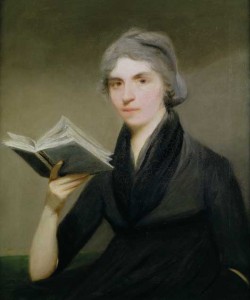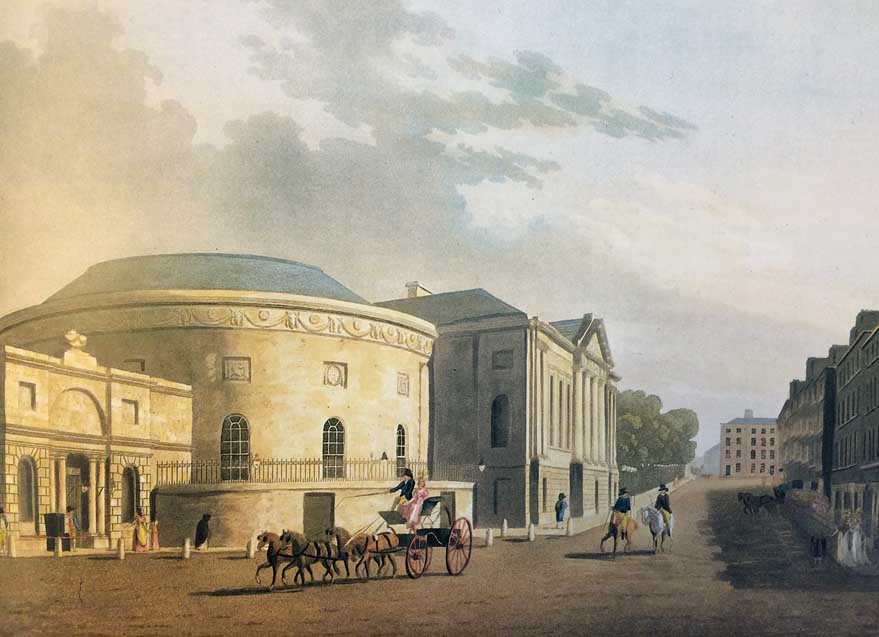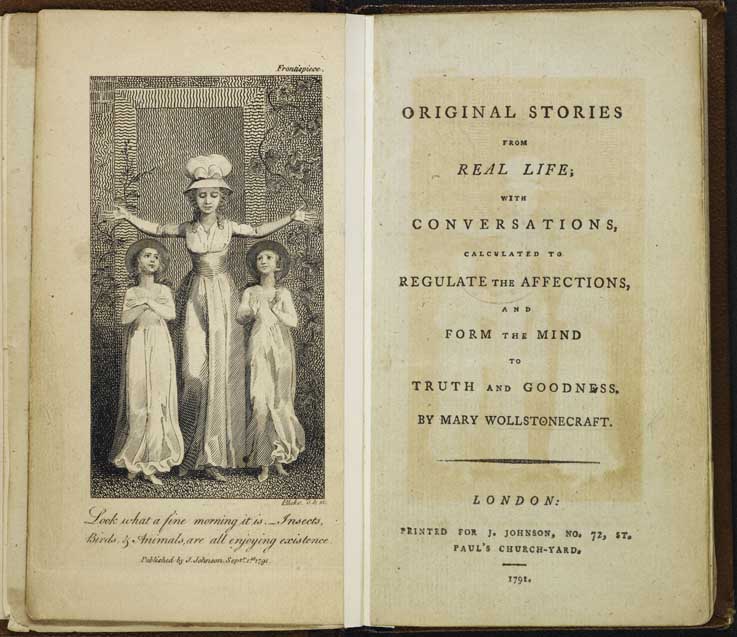From the Education of daughters to the Rights of woman: Mary Wollstonecraft in Ireland, 1786–7
Published in 18th–19th - Century History, Features, Issue 1 (January/February 2016), Volume 24WOLLSTONECRAFT’S EXPERIENCES IN IRELAND HELPED INFORM HER RADICAL CLASS AND GENDER ANALYSES
By Jenny McAuley

Portrait of Mary Wollstonecraft (c. 1787) attributed to the Irish painter John Keenan, pupil of her friend Betty Delane’s brother-in-law, Robert Home. (Bridgeman Library)
In October 1786, the 27-year-old Mary Wollstonecraft travelled to Ireland to take up a new post as governess to the three daughters of Lord and Lady Kingsborough of Mitchelstown Castle, Co. Cork. Wollstonecraft hoped that the salary of 40 guineas would enable her to pay off long-standing debts to friends and tradesmen. She also sought financial security to develop her career as a professional writer, having just submitted her first book, a collection of short essays entitled Thoughts on the education of daughters, to the progressive London bookseller Joseph Johnson. Employed by one of the wealthiest Anglo-Irish Ascendancy families, Wollstonecraft gained intimate insights into the privileged yet restricted lives of aristocratic women that her own impoverished middle-class background could never have afforded. Along with her studies in philosophy and literature, and her later engagement with French Revolutionary principles, Wollstonecraft’s experiences in Ireland crucially informed her radical class and gender analyses in A vindication of the rights of woman (1792).
Setbacks
By the time she set off for Mitchelstown, Wollstonecraft had been confronted with the failure that year of the girls’ school she had run at Newington Green, east London, with her sisters Everina Wollstonecraft and Eliza Bishop. She was still grieving the loss of her beloved friend Frances Skeys (née Blood), who had died following childbirth in 1785. With her variously spendthrift and stingy male relatives providing no reliable support, Wollstonecraft refused to allow her distress at these events to affect her determination to earn her own subsistence.
Wollstonecraft became aware of the opportunity at Mitchelstown through a Newington Green neighbour, Sarah Burgh, the friend of a Mr Prior, a master at Eton College (where two of the Kingsborough sons were pupils), and his wife. The Priors having mentioned to Mrs Burgh that the Kingsboroughs required a governess, Wollstonecraft was put forward as a suitable candidate. Wollstonecraft was encouraged to accept the Kingsboroughs’ eventual offer of employment by her initially positive impression of Caroline King, Lady Kingsborough. Writing to Mrs Prior, Caroline had admitted that her daughters’ ‘minds’ had been neglected by governesses who had ‘only attended the ornamental part of their education’—meaning their training in fashionable comportment and feminine accomplishments such as dancing.
These sentiments prejudice me in her favour,’ Wollstonecraft wrote to Everina, having herself criticised the superficiality of conventional girls’ education in Thoughts on the education of daughters.
Network of family and friends
Working in Ireland, Wollstonecraft hoped to maintain contact with Frances’s widower, Hugh Skeys, a Dublin merchant, and the surviving members of the Blood family, who were themselves of Anglo-Irish origin. Frances’s brother George had gone to work for a wine merchant at 96 Great Britain Street, Dublin, while at 48 Great Britain Street Frances’s and Wollstonecraft’s mutual friend Betty Delane had joined the household of her sister, Susanna Home, the Irish wife of the English-born portrait artist Robert Home. Wollstonecraft had relatives of her own in Cork—her mother Elizabeth Dickson, who had died in 1782, was Irish—but she felt closer to George Blood and Betty Delane.

The first stage of Wollstonecraft’s journey from London to Mitchelstown took her to Eton, where she expected to be joined by the Kingsborough sons. When the absent boys failed to arrive, Wollstonecraft continued alone to Holyhead. From there, she sailed by packet-boat to Dublin. She spent some days with George Blood and Betty Delane before a butler sent from Mitchelstown arrived to escort her onward to Cork. Wollstonecraft entered the imposing gates of Mitchelstown Castle feeling ‘as I should if I were going into the Bastille’. She feared that her experience as a schoolmistress had been an inadequate preparation for employment in an aristocratic household.
Although always conscious of her inferior rank while living with the Kingsboroughs, Wollstonecraft was pleased that her employers treated her courteously—‘like a gentlewoman’ (her husband William Godwin reported in his 1798 Memoirs of the author of A Vindication of the Rights of Woman that it was Wollstonecraft who insisted upon such treatment). While Wollstonecraft’s first impression of her pupils—aged fourteen, twelve, and six—was that they were ‘wild Irish, unformed’, she quickly gained their affection, although she continued to be challenged by their lack of discipline.
When not engaged in teaching, Wollstonecraft was often lonely at Mitchelstown—despite her appreciation of the spectacular local scenery of the Galtee Mountains. Occupying a genteel yet still subordinate status, she could not join uninvited in the leisured diversions of the family. She was likewise excluded from the social life of the castle servants, whom she could hear from their own quarters when they entertained themselves with dancing to fiddle music.
Contemporary cult of sensibility
Over time, Lady Kingsborough became impressed with Wollstonecraft’s talent for intelligent conversation. She showed her off to house guests, and included her in informal socialising with her stepmother, Mrs Fitzgerald, and Mrs Fitzgerald’s three unmarried daught-ers. Previously, Wollstonecraft had only glimpsed the ways of the fashionable élite at Bath and Windsor in England, as paid companion to an older widow. Now she observed at first hand the grooming of high-status women for courtship and marriage in a period when fashion, influenced by the contemporary cult of sensibility, dictated that women should cultivate an appearance of sweetness and innocence, even to the point of affecting whimsical, childishly playful manners.
While the Fitzgerald girls’ chatter about shopping and suitors was irritating to Wollstonecraft, in Caroline King she witnessed the consequences of idealising ‘feminine’ delicacy for married women faced with the responsibilities of motherhood. At 33, Caroline was only five years older than Wollstonecraft, having married at the age of fifteen—one year older than her eldest daughter, Margaret. As Wollstonecraft acknowledged, the society beauty Caroline was in fact ‘a shrewd clever woman’ and charitable to the Mitchelstown poor, but she was also vain and given to violent displays of temper. Much as Wollstonecraft disliked Caroline’s use of rouge and her affected ‘infantine lisp’, she was especially distressed to see her lavishing affection upon her six lapdogs while apparently neglecting her children’s moral and emotional welfare. Lisping and lapdogs would feature in Wollstonecraft’s disapproving anecdotes about an unnamed lady of her personal acquaintance in Chapter 11 of A vindication of the rights of woman.
As Wollstonecraft discovered, her pupils had been spoiled by a combination of over-indulgence and excessive restraint. Their mother’s temper frightened them, and Wollstonecraft found it a delicate task to counteract Caroline’s bad influence upon her daughters without inciting them to disrespect. Finding that Margaret had promising intellectual abilities, Wollstonecraft was also frustrated at having to spend so much time supervising her pupils in acquiring what she regarded as ‘a heap of rubbish mis-called accomplishments’.

Social life in Dublin
In February 1787 Wollstonecraft accompanied the Kingsboroughs to Dublin, where they lived partly at 15 Merrion Square but also with Lord Kingsborough’s father, the first earl of Kingston, at his townhouse (now 15 and 16 Henrietta Street). Wollstonecraft hoped for more leisure for study, imagining that Caroline would be too much pre-occupied with the fashionable life centred around the vice-regal court at Dublin Castle to make demands on her spare time. As Wollstonecraft discovered, however, Caroline’s preparations for attending society functions could involve the entire household, including herself, for days. It would be mainly late at night that Wollstonecraft found time and privacy for writing.
In Dublin, Wollstonecraft was ever more in demand in the Kingsboroughs’ drawing room. She also accompanied Lady Kingsborough to assemblies at the Rotunda, to the theatres, and to concerts held at St Werburgh’s Church that May to commemorate G. F. Handel’s residence in Dublin in 1740–1. She even attended a masquerade as ‘interpreter’ to a Miss Moore, who had gone as a Pacific Islander supposedly unable to speak English. Long disgusted by the opulence and snobbishness of Ascendancy society, Wollstonecraft gave ‘full scope to a satyrical vein’ from behind her mask.
Beyond the Kingsborough household, Wollstonecraft was befriended by the wife of George Ogle, the suave, middle-aged Irish Whig MP who had impressed her with his gentlemanly manners—and by his having authored the popular lyric ‘The Banks of Banna’—when she had met him at Mitchelstown (the radical Wollstonecraft was less impressed, in later years, to realise the extent of Ogle’s ultra-Protestantism, and while still in Dublin she came to disapprove of what she termed his ‘sensuality’). It may also have been in Dublin that Wollstonecraft sat for the portrait by the Irish painter John Keenan, pupil of Betty Delane’s brother-in-law Robert Home, which has been dated to c. 1787. It was certainly at this time that she became a published author, with the appearance of Thoughts on the education of daughters in early 1787.
Dismissal
Despite the cheerful—even brilliant—front she kept up in company, Wollstonecraft was profoundly discontented. Aware that the liberty and privileges she enjoyed were subject to Caroline King’s caprices, she began to assert her independence, angering Caroline when she declined invitations and gifts. She also found herself exposed to Caroline’s envy of the flattering attention she received from Ogle and others. Caroline resented still more Margaret’s apparent preference for Wollstonecraft over herself. This circumstance was cited to Wollstonecraft as the reason for her dismissal from the Kingsboroughs’ employment in the summer of 1787, after she had accompanied them to Bristol Hot Wells.
With her first book in print, Wollstonecraft now felt confident to devote herself fully to writing. Her publisher, Johnson, supported her in establishing herself as a professional author in London. By the end of 1787 she had completed a novel, Mary (published in 1788), in which she drew upon observations of Caroline and Ogle. More closely based on her Irish experiences was her book for children, Original stories from real life (1788). Reprinted in 1791 with illustrations by William Blake, Original stories features an enlightened governess, Mrs Mason, who cures two spoilt girls of laziness, slovenliness and unkindness.
After the Kingsboroughs dismissed her, Wollstonecraft never saw Margaret King again, though for some time they secretly corresponded. In her later, married life as Countess Mount Cashell, Margaret energetically lived out Wollstonecraft’s democratic and feminist ideals, becoming a major Irish Patriot hostess, and subsequently pursuing a literary career and the independent study of medicine. After separating from her husband, Margaret settled in Italy with George Tighe, assuming the name ‘Mrs Mason’ in Wollstonecraft’s honour. Having befriended Wollstonecraft’s widower, William Godwin, during his visit to Ireland in 1800 (see HI 23.4, July/Aug. 2015, pp 22–4), Margaret developed close friendships with Wollstonecraft’s and Godwin’s daughter, Mary, and with her husband Percy Bysshe Shelley and stepsister Claire Clairmont, after they came to live near her at Pisa in 1819.
Mary Wollstonecraft’s sisters, Everina Wollstonecraft and Eliza Bishop, also found work as governesses in Ireland. By the early 1800s they had jointly established a preparatory school at 17 Hume Street, Dublin, where pupils included the children of Daniel O’Connell.
Read More: Background
Read More: The Kingsborough family and Mitchelstown Castle
Jenny McAuley is a postdoctoral research assistant in the School of English and Drama, Queen Mary University of London.
Further reading
L. Gordon, Vindication: a life of Mary Wollstonecraft (London, 2006).
B. Power, From the Danes to Dairygold: a history of Mitchelstown (Mitchelstown, 1996).
J. Todd, Rebel daughters: Ireland in conflict 1798 (London, 2003).
J. Todd (ed.), The collected letters of Mary Wollstonecraft (London, 2003).
















